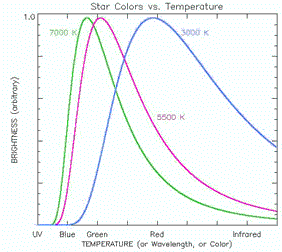All Stars are White
Bad Astronomy: All stars that you can see at night are white. Good Astronomy: Stars actually emit all the colors of the rainbow. Literally!I have had a couple of people email me and suggest this as a Bad Astronomy topic. I don't think it's Bad, so much as Not Really Thought About. Most people don't really think about stars having colors, so they tacitly assume all stars are white. But look at the Sun! It looks yellow to me, and it's a star!
This one is easy to disprove by yourself. Go outside on a clear night and look at the stars. The best ones to look at are the brightest. In the Summer, (for the Northern Hemisphere) Vega is a bright star high overhead, and is clearly blue. Antares is another summer star and is also clearly red (or orange). In the Winter, you can see Betelgeuse in the constellation of Orion, which is very red. Aldebaren, a star in Taurus (near Orion) is also very red.
But most of the dimmer stars really do look white. What's going on here?
First off, stars really do have all different colors. Back in the 19th century (and before) it was known that when you heat an object up, it glows, and furthermore the color of the glow depends on the temperature of the object. A man named Wien (pronounced "Veen"; he was German) was even able to apply some math to this and calculate the temperature of an object given its color, although just why this worked was unknown. It wasn't until the 20th century that this was understood, when another scientist named Planck helped develop quantum mechanics.
Mind you, this only works for objects that are glowing, and therefore giving off their own light, and not objects that are simply reflecting light.
Color is just another word for wavelength; light behaves like a wave, and the color of the light depends on the wavelength. Planck worked out a mathematical relation of temperature, color and brightness of a freely glowing object. He found, as Wien did, that an object at a given temperature will emit most of its light at a certain wavelength, and less at all other wavelengths. When you plot up the brightness of an object versus the wavelength (or color), you get a curve now called a "Planck curve", or a "blackbody curve", because it represents a black object heated up. The plot below shows three such curves scaled so that the peak brightness are the same. See how the hottest one (at 7000 degrees Kelvin, a temperature scale much like Centigrade) peaks at a wavelength that is blue, and the cooler one (at 3000 K) at red? The one in between (5500 K) peaks in the green. [Note(added September 29, 2000): the graphic below is a bit confusing. The original colors of the plots matched the stars I discuss in the text, but somehow got messed up when put on the page. I'll fix this when I get a chance. Sorry about the confusion!]

So, back to the original question: why do so many stars look white? Are most of them like the Sun?
Nope. Oddly, the vast majority of stars in the sky are cool, red stars, usually too dim to see. The reason most stars appear white to us is because we have two different kind of light sensors in our eyes. Sensors called "rods" detect brightness, while sensors called "cones" detect color. The cones are not very sensitive, so if a light is too dim they are not activated, and we perceive the color as white. So even a red star looks white if it is dim, and only brighter stars look like they have color to us!
If you have a pair of binoculars, look at some stars that are bright but still look white to your naked eye. You'll find that lots of them through the binoculars suddenly have color! The binoculars focus more light into your eye, and for brighter stars there will be enough light to activate the cones in your eye. A telescope will show even more stars with colors. There is a star, named Albireo, that to the naked eye looks like one star, but is actually two in close orbit around each other. One of the stars is a striking red, while the other a brilliant blue. Through even a modest telescope this is one of the most beautiful sights in the sky.
No comments:
Post a Comment